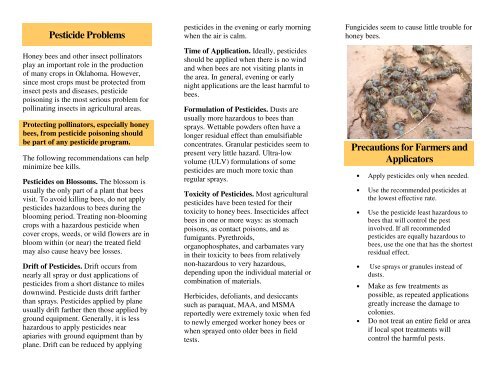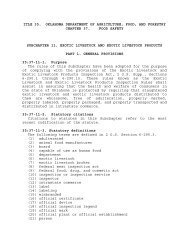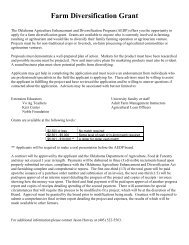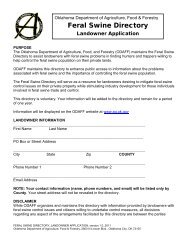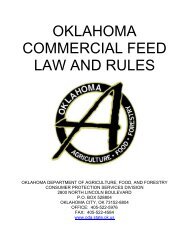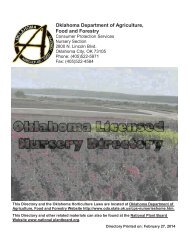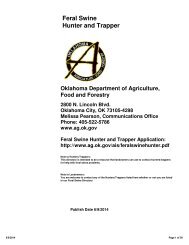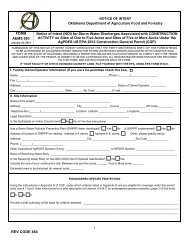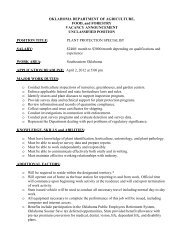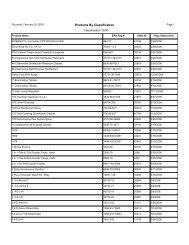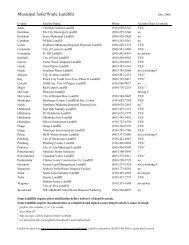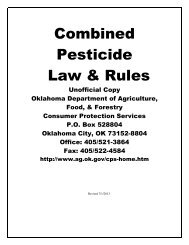Protecting Honey Bees from Pesticides - Oklahoma Department of ...
Protecting Honey Bees from Pesticides - Oklahoma Department of ...
Protecting Honey Bees from Pesticides - Oklahoma Department of ...
Create successful ePaper yourself
Turn your PDF publications into a flip-book with our unique Google optimized e-Paper software.
Pesticide Problems<strong>Honey</strong> bees and other insect pollinatorsplay an important role in the production<strong>of</strong> many crops in <strong>Oklahoma</strong>. However,since most crops must be protected <strong>from</strong>insect pests and diseases, pesticidepoisoning is the most serious problem forpollinating insects in agricultural areas.<strong>Protecting</strong> pollinators, especially honeybees, <strong>from</strong> pesticide poisoning shouldbe part <strong>of</strong> any pesticide program.The following recommendations can helpminimize bee kills.<strong>Pesticides</strong> on Blossoms. The blossom isusually the only part <strong>of</strong> a plant that beesvisit. To avoid killing bees, do not applypesticides hazardous to bees during theblooming period. Treating non-bloomingcrops with a hazardous pesticide whencover crops, weeds, or wild flowers are inbloom within (or near) the treated fieldmay also cause heavy bee losses.Drift <strong>of</strong> <strong>Pesticides</strong>. Drift occurs <strong>from</strong>nearly all spray or dust applications <strong>of</strong>pesticides <strong>from</strong> a short distance to milesdownwind. Pesticide dusts drift fartherthan sprays. <strong>Pesticides</strong> applied by planeusually drift farther then those applied byground equipment. Generally, it is lesshazardous to apply pesticides nearapiaries with ground equipment than byplane. Drift can be reduced by applyingpesticides in the evening or early morningwhen the air is calm.Time <strong>of</strong> Application. Ideally, pesticidesshould be applied when there is no windand when bees are not visiting plants inthe area. In general, evening or earlynight applications are the least harmful tobees.Formulation <strong>of</strong> <strong>Pesticides</strong>. Dusts areusually more hazardous to bees thansprays. Wettable powders <strong>of</strong>ten have alonger residual effect than emulsifiableconcentrates. Granular pesticides seem topresent very little hazard. Ultra-lowvolume (ULV) formulations <strong>of</strong> somepesticides are much more toxic thanregular sprays.Toxicity <strong>of</strong> <strong>Pesticides</strong>. Most agriculturalpesticides have been tested for theirtoxicity to honey bees. Insecticides affectbees in one or more ways: as stomachpoisons, as contact poisons, and asfumigants. Pyrethroids,organophosphates, and carbamates varyin their toxicity to bees <strong>from</strong> relativelynon-hazardous to very hazardous,depending upon the individual material orcombination <strong>of</strong> materials.Herbicides, defoliants, and desiccantssuch as paraquat, MAA, and MSMAreportedly were extremely toxic when fedto newly emerged worker honey bees orwhen sprayed onto older bees in fieldtests.Fungicides seem to cause little trouble forhoney bees.Precautions for Farmers andApplicators• Apply pesticides only when needed.• Use the recommended pesticides atthe lowest effective rate.• Use the pesticide least hazardous tobees that will control the pestinvolved. If all recommendedpesticides are equally hazardous tobees, use the one that has the shortestresidual effect.• Use sprays or granules instead <strong>of</strong>dusts.• Make as few treatments aspossible, as repeated applicationsgreatly increase the damage tocolonies.• Do not treat an entire field or areaif local spot treatments willcontrol the harmful pests.


